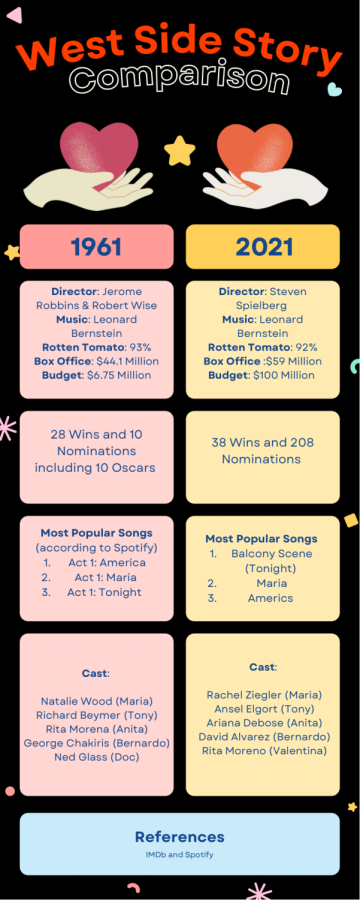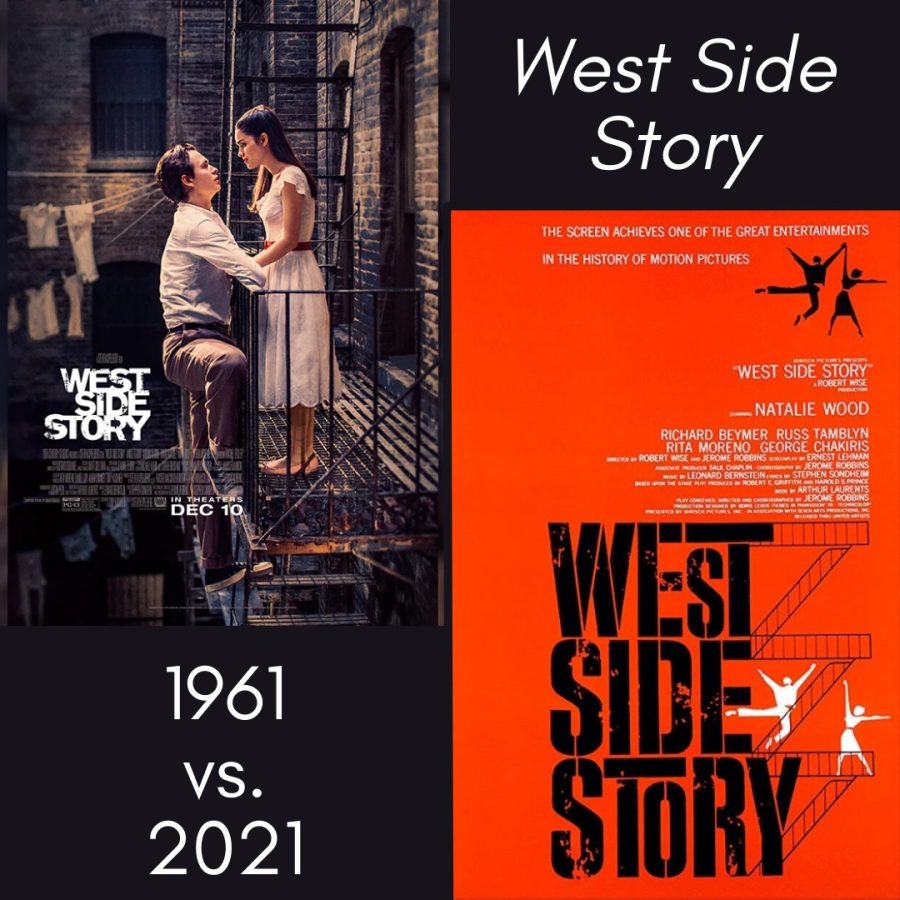West Side Story returns after 60 years
20th Century Studios and Leonard Bernstein Office/Arianna Morales/Canva
The remake of “West Side Story” is the classic story, but retold sixty later on the big screen with a brand new cast.
A classic story retold. Romeo and Juliet in the streets of New York, reimagined again.
Six decades earlier, Natalie Wood’s “Maria” and Richard Beymer’s “Tony” fateful love first graced the screen. The audience fell in love with the story as fast as the renditions of Romeo and Juliet fell in love with each other.
Now Spielberg aims to retell West Side Story on the big screen with a new cast but the same story, along with some other changes.
How do the two films differ? Or Are their respective eras the only thing that sets them apart? This review aims to answer this question spoiler free.
The original musical movie adaption of the musical West Side Story was an instant hit. It was deemed revolutionary for its time because of its stunning realism: the very streets of New York featured in the first few minutes of the film as a long panoramic shot of various iconic locations.
“‘The realness of a travel log,’[and] ‘a starkly realistic crime film’ [aren‘t] phrases a critic would have associated with movie musicals at that point in American cinema,” according to Be Kind Rewind.
This was a stark contrast to the fantastical sets typical of movie musicals during the time. “These films were meant to enchant and to glamorize.” West Side Story captured raw emotions while seamlessly portraying the essence of New York throughout the film.

Most (if not all) songs felt captivating and sent chills to the audience as the emotions of every character radiated: love and hate and everything in between; if it wasn’t the singing, it was the skillful dancing that painted the tense racial divide against the budding romance of Maria and Tony.
However, it did have its own flaws, one of them being, ironically, the lack of authenticity when it came to framing the immigrant experience. More specifically, the Puerto Rican immigrant experience in New York in the late 50s. Natalie Wood was Russian American and George Charikis (Bernardo) was Greek American.
Furthermore, much of the singing was dubbed and the “Hispanics” were told to wear dark makeup despite the fact that Puetro Ricans can be any color, as argued by the iconic “Anita,” actress Rita Moreno, one of the few actual Puerto Rican actors cast in the original film.
Ghost singing and casting regardless of ethnic relation to the role were common practices in the film industry at the time.
That’s where Spielberg comes in. The new version of West Side Story emphasizes the Latino immigrant experience through smooth integration of Spanish dialect woven regularly into dialogue and the Hispanics casted both in prominent and minor roles.
In addition, multiple characters, especially Tony and Riff contain more dimension compared to their counterparts.
The placement and lyrics of some songs have also changed. Particularly, “Cool” has a refreshed meaning as it foreshadows conflict and similarly showcases the temptation for violence while “I Feel Pretty” has new bittersweet undertones.
Although 2021’s version was officially a box office bomb, most likely due to the number of anticpated films like SpiderMan: No Way Home and others taking precedence, it nonetheless enhanced 1961’s authenticity to the lives of rival gangs in the streets of New York.
Both films tell the tale of the persistence of passion: vengeful hate and the sweetest love constantly at ends with each other. It describes humanity’s selfish insistence to tradition and reluctance to change.
As the credits scroll and the music flows through reprisals of chilling songs like “Maria” and “Tonight,” it makes one wonder: can love break through a whirlwind of hate if it were strong enough?
Both movies give ambiguous messages that ultimately leave the viewer with the final decision. A choice to love or hate others and be willing to accept its consequences.



